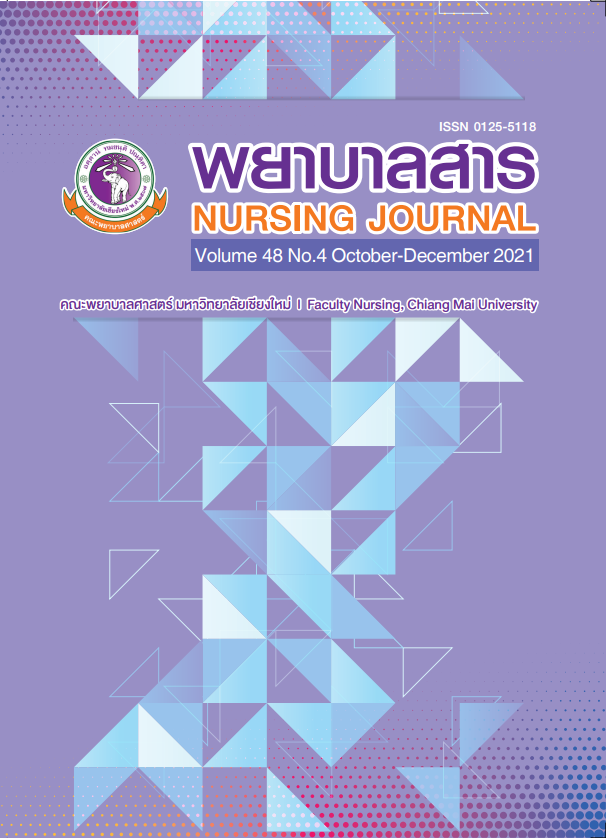การรับรู้สมรรถนะแห่งตน การสนับสนุนทางสังคม และการจัดการตนเองในเด็กวัยรุ่นโรคธาลัสซีเมีย
คำสำคัญ:
การจัดการตนเอง, เด็กวัยรุ่น, โรคธาลัสซีเมีย, การรับรู้สมรรถนะแห่งตน, การสนับสนุนทางสังคมบทคัดย่อ
การจัดการตนเองที่เหมาะสมในเด็กวัยรุ่นโรคธาลัสซีเมีย จะทำให้เกิดผลลัพธ์ที่ดีทางสุขภาพ และเข้าสู่วัยผู้ใหญ่ได้อย่างมีประสิทธิภาพ การวิจัยเชิงพรรณนาหาความสัมพันธ์ครั้งนี้มีวัตถุประสงค์เพื่อศึกษาการจัดการตนเองในเด็กวัยรุ่นโรคธาลัสซีเมีย และความสัมพันธ์ระหว่างการรับรู้สมรรถนะแห่งตน การสนับสนุนทางสังคมกับการจัดการตนเองในเด็กวัยรุ่นโรคธาลัสซีเมีย โดยใช้กรอบแนวคิดการจัดการตนเองของ Schilling, Grey, & Knafl, (2002) และ Schilling et al., (2009) ร่วมกับการทบทวนวรรณกรรม กลุ่มตัวอย่าง คือ เด็กวัยรุ่นโรคธาลัสซีเมีย ที่มีอายุระหว่าง 15 - 17 ปี ที่มารับการรักษาที่คลินิกโรคธาลัสซีเมียหรือคลินิกโรคเลือด โรงพยาบาลระดับตติยภูมิ 3 แห่ง ในภาคตะวันออกเฉียงเหนือ ตั้งแต่เดือนกรกฎาคม ถึงเดือนตุลาคม พ.ศ. 2560 จำนวน 85 ราย คัดเลือกแบบเฉพาะเจาะจง เครื่องมือที่ใช้รวบรวมข้อมูล ประกอบด้วย แบบสอบถามการรับรู้สมรรถนะแห่งตนในการจัดการตนเอง แบบสอบถามการสนับสนุนทางสังคมในการจัดการตนเอง และแบบสอบถามการจัดการตนเองในเด็กวัยรุ่นโรคธาลัสซีเมีย มีค่าดัชนีความตรงตามเนื้อหาเท่ากับ 0.90, 1.00 และ 1.00 ตามลำดับ และมีค่าความเชื่อมั่นเท่ากับ 0.74, 0.72 และ 0.81 ตามลำดับ วิเคราะห์ข้อมูลโดยใช้สถิติพรรณนา และสัมประสิทธิ์สหสัมพันธ์แบบสเปียร์แมน ผลการศึกษาพบว่า 1. เด็กวัยรุ่นโรคธาลัสซีเมียร้อยละ 81.18 มีคะแนนเฉลี่ยการจัดการตนเองในอยู่ในระดับสูง (x= 69.72, S.D. = 8.31) 2. การรับรู้สมรรถนะแห่งตน และการสนับสนุนทางสังคม มีความสัมพันธ์ทางบวกในระดับปานกลางกับการจัดการตนเองในเด็กวัยรุ่นโรคธาลัสซีเมีย อย่างมีนัยสำคัญทางสถิติ (r = .49, p < .001, r = .45, p < .001) ตามลำดับ ผลการวิจัยในครั้งนี้สามารถนำมาเป็นข้อมูลพื้นฐานสำหรับบุคลากรทางสุขภาพที่เกี่ยวข้องโดยเฉพาะอย่างยิ่งพยาบาล ในการส่งเสริมการจัดการตนเองในเด็กวัยรุ่นโรคธาลัสซีเมียให้มีประสิทธิภาพ ซึ่งจะช่วยให้มีคุณภาพชีวิตที่ดีและลดการเกิดภาวะแทรกซ้อนต่อไป
เอกสารอ้างอิง
Delea, T. E., Edelsberg, J., Sofrygin, O., Thomas, S. K., Baladi, J. F., Phatak, P. D., & Coates, T. D. (2007). Consequences and costs of noncompliance with iron chelation therapy in patients with transfusion-dependent thalassemia: A literature review. Transfusion, 47(10), 1919-1929.
Fucharoen, S., Tanpaijit, W., Torjarat, K., Wipraksit, W., & kaewkuychr, A. (2017). Guidelines for the care of thalassemia patients in general practice. Bangkok: Paliving printing. (in Thai)
Fucharoen, S. (2013). Anemia, thalassemia and hemoglobinopathies in northeast Thailand, Lao PDR and Vietnam. Srinagarind Medical Journal, 28(4), 153-157. (in Thai)
Iannotti, R. J., Schneider, S., Nansel, T. R., Haynie, D. L., Plotnick, L. P., Clark, L. M., & Simons-Morton, B. (2006). Self-efficacy, outcome expectations, and diabetes self-management in adolescents with type 1 diabetes. Journal of Developmental & Behavioral Pediatrics, 27(2), 98-105.
Ontrakrai, N., Jintrawet, U., & Chotibang, J. (2016). Factors Related to Self-Management Behaviors in Adolescent with Type 1 Diabetes. Nursing Journal, 48(2), 246-258. (in Thai)
Pansuwan, A., Fucharoen, G., Fucharoen, S., Himakhun, B., & Dangwiboon, S. (2011). Anemia, iron deficiency and thalassemia among adolescents in northeast Thailand: Results from two independent surveys. Acta Haematologica Journal, 125(4), 186-192.
Piga, A., Gaglioti, C., Fogliacco, E., & Tricta, F. (2003). Comparative effects of deferiprone and deferoxamine on survival amd cardiac disease im patients with thalassemia major:A retrospective analysis. Haematologica, 88(1), 489-496.
Polit, D. F. (2010). Statistic and data analysis for nursing research (2nd ed.). New Jersey: Pearson Education.
Razzazan, N., Ravanipour, M., Jahanpour, F., Zarei, A. R., Motamed, N., & Hosseini, S. (2014). Investigating challenges facing self-management empowerment education in adolescents and youths with major thalassemia. Jundishapur Journal of Chronic Disease Care, 3(4), 1-7.
Rhee, H., Belyea, M. J., Ciurzynski, S., & Brasch, J. (2009). Barriers to asthma self-management in adolescents: Relationships to psychosocial factors. Pediatric Pulmonology, 44(2), 183-191.
Schilling, L. S., Grey, M., & Knafl, K. A. (2002). The concept of self-management of type 1 diabetes in children and adolescents: An evolutionary concept analysis. Journal of Advanced Nursing, 37(1), 87-99.
Schilling, L. S., Dixon, J. K., Knafl, K. A., Lynn, M. R., Murphy, K., Dumser, S., & Grey, M. (2009). A new self-report measure of self-management of type 1 diabetes for adolescents. Nursing Research, 58(4), 228-236.
Sin, M. K., Kang, D. H., & Weaver, M. (2005). Relationships of asthma knowledge, self-management, and social support in African American adolescents with asthma. International Journal of Nursing Studies, 42(3), 307-313.
Srikulwong, N., Kantawang, S., & Jintrawet, U. (2012). Factors influencing health promotion behaviors of adolescents with epilepsy. Nursing Journal, 39(4), 23-33. (in Thai)
Thoraphan, R., Teerarungsikul, N., Sananreungsak, S., (2017). Factors related to discomfort symptom management of thalassemia children treated by iron chelation. Journal of Health and Nursing Education, 23(2), 32-46. (in Thai)
Vichinsky, E. (2005). Changing patterns of thalassemia worldwide. Annals of the New York Academy of Sciences, 1054(1), 18-24.
ดาวน์โหลด
เผยแพร่แล้ว
รูปแบบการอ้างอิง
ฉบับ
ประเภทบทความ
สัญญาอนุญาต
บทความที่ได้รับการตีพิมพ์เป็นลิขสิทธิ์ของวารสารพยาบาลสาร
ข้อความที่ปรากฏในบทความแต่ละเรื่องในวารสารวิชาการเล่มนี้เป็นความคิดเห็นส่วนตัวของผู้เขียนแต่ละท่านไม่เกี่ยวข้องกับมหาวิทยาลัยเชียงใหม่ และคณาจารย์ท่านอื่นๆในมหาวิทยาลัยฯ แต่อย่างใด ความรับผิดชอบองค์ประกอบทั้งหมดของบทความแต่ละเรื่องเป็นของผู้เขียนแต่ละท่าน หากมีความผิดพลาดใด ๆ ผู้เขียนแต่ละท่านจะรับผิดชอบบทความของตนเองแต่ผู้เดียว






